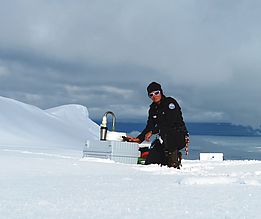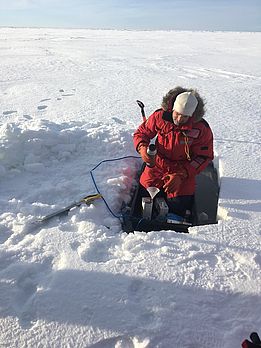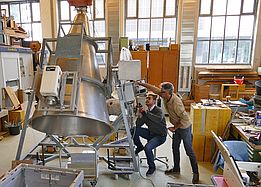Encased in thick ice, the research icebreaker Polarstern will spend almost a year drifting hundreds of kilometres through the Arctic Ocean. Switzerland is involved in this unique expedition: researchers from the Swiss Federal Institute for Forest, Snow and Landscape Research (WSL) and the Paul Scherrer Institute (PSI) are on the expedition team, and Swiss-designed experiments will be on board the vessel.
Tonight, the German research icebreaker Polarstern will set out from Tromsø (Norway) on a sea expedition unlike any the world has seen before. Around a month from now, north of Siberia, the Polarstern will be moored to a large floe formed from last year’s ice. The water will freeze around it, enclosing it completely. It will then spend several months encased in the ice floe, during which it will drift several hundred kilometres through the Arctic Ocean, passing close to the North Pole. After a polar night lasting 150 days, the sun will eventually appear on the horizon again. However, it will be late summer 2020 before the icebreaker is released from the floe, most likely somewhere north-east of Greenland.
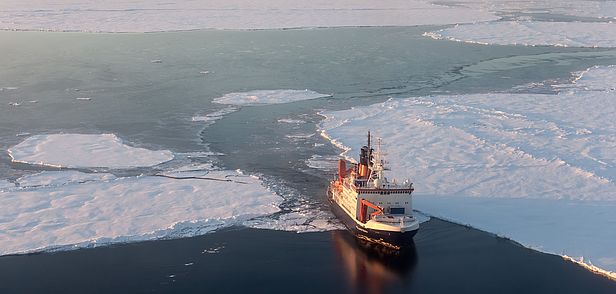
A total of around 600 people from almost 20 countries are involved in this one-of-a-kind expedition, which is being organised by the Alfred Wegener Institute (AWI). The expedition aims to gain an insight into how the atmosphere, ocean, sea ice and ecosystem interact in the Arctic – particularly in winter, given that so little research has been conducted in winter conditions to date. The main focus of the expedition is the Arctic climate system, which is especially severely affected by climate change. The Arctic climate system also plays a vital role in the climate of the entire Northern Hemisphere, yet too little is known about it at present. Accordingly, the expedition was named Multidisciplinary drifting Observatory for the Study of Arctic Climate (MOSAiC).
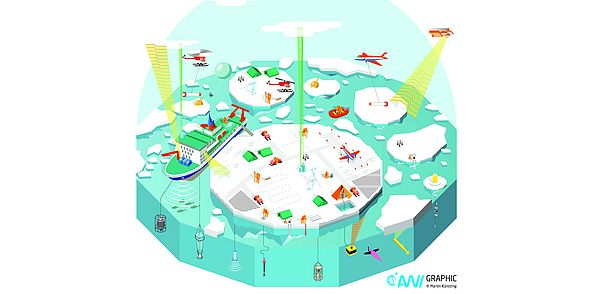
Swiss projects on board
Swiss atmospheric researcher Julia Schmale of PSI, who is taking part in the expedition, explains more: “Global emissions of greenhouse gases and the particulate matter produced in Europe, Asia and North America affect climate change in the Arctic. In turn, the rising temperature and the decline of the sea ice have an impact on weather systems in Europe, for instance. It is therefore vital to understand how we influence the Arctic and how it influences us.” Schmale’s project examines how and on which natural and man-made condensation nuclei (particles) clouds form. Since clouds reduce the flow of energy from the sun to the earth’s surface and radiation from the earth’s surface into space, they have a significant impact on temperatures in the Arctic: their effect is predominantly warming.
Martin Schneebeli of WSL, who heads the expedition’s second Swiss project, adds: “The exchange of energy between the atmosphere and the ocean is another important factor in the climate system. Sea ice and the snow lying on it slow down this exchange, just like the clouds higher up. Our project studies this interaction.”
To be able to record the thickness and other properties of sea ice regularly in the future, WSL’s Mike Schwank developed a device that measures the microwaves emitted by sea ice. Reza Naderpour uses the device in the area around the Polarstern and compares the results with measurements taken from satellites. “This should make it possible to observe and better record the changes affecting Arctic sea ice as a result of climate change, despite the long, dark winter,” explains Schwank.
The projects are receiving funding from the Swiss Polar Institute (SPI), which contributes towards the high logistics costs associated with Swiss groups’ scientific activities in polar regions. Organisations including Scanco Medical, ARICE (Arctic Research Icebreaker Consortium) and the ESA (European Space Agency) are giving financial or material support to individual projects, while the Swiss Committee on Polar and High Altitude Research (SKPH) is providing soft support.
Contact
- Julia Schmale, PSI – available by email or mobile phone in Tromsø on 20 and 21 September: julia.schmale(at)psi.ch, +41 76 410 46 75
- Martin Schneebeli, WSL – available by email or mobile phone in Tromsø on 20 and 21 September: schneebeli(at)slf.ch; +41 79 389 5008 (send a text message before calling, as there is not always a mobile phone signal)
- Mike Schwank, WSL: +41 79 563 98 57, mike.schwank(at)wsl.ch
- Reza Naderpour, WSL: +41 79 637 84 89, reza.naderpour(at)wsl.ch
Links and Documents
- All about the expedition: www.mosaic-expedition.org (Website), follow.mosaic-expedition.org (Progressive Web App), https://www.awi.de/ueber-uns/service/presse.html (Media release of AWI) and https://www.youtube.com/user/AWIresearch
- From Snow Researcher to Seafarer Blogpost by David Wagner
- Alfred Wegener Institute (AWI) media centre, which features interesting photos and infographics: multimedia.awi.de
- Swiss Committee on Polar and High Altitude Research (SKPH)
- Swiss Polar Institut (SPI)
Official Boilerplate
During the MOSAiC expedition, researchers from 19 countries will explore the Arctic for an entire year. For this purpose, from autumn 2019 to autumn 2020, the German icebreaker Polarstern will drift through the Arctic Ocean, trapped in the ice. MOSAiC is spearheaded by the Alfred Wegener Institute, Helmholtz Centre for Polar and Marine Research (AWI). To ensure that this unique project is a success and as much valuable data as possible can be gathered, more than 70 institutes will pool their resources in a research consortium. The expedition budget is about 140 million euros.
The latest news straight from the Arctic can be found on the MOSAiC channels on Twitter and Instagram under the hashtags #MOSAiCexpedition, #Arctic and #icedrift. For further information on the expedition, please visit: www.mosaic-expedition.org and follow.mosaic-expedition.org.
Copyright
WSL and SLF provide image and sound material free of charge for use in the context of press contributions in connection with this media release. The transfer of this material to image, sound and/or video databases and the sale of the material by third parties are not permitted.

